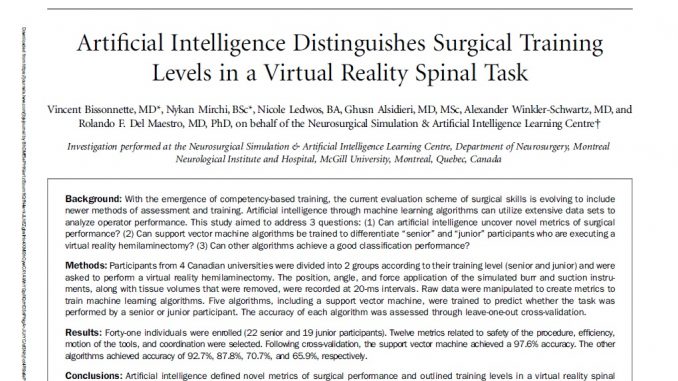
The Journal of Bone and Joint Surgery (September 20, 2019)
Bissonnette, Vincent MD, Mirchi, Nykan BSc, Ledwos, Nicole BA, Alsidieri, Ghusn MD, MSc, Winkler-Schwartz, Alexander MD, Del Maestro, Rolando F. MD, PhD1 on behalf of the Neurosurgical Simulation & Artificial Intelligence Learning Centre
Background: With the emergence of competency-based training, the current evaluation scheme of surgical skills is evolving to include newer methods of assessment and training. Artificial intelligence through machine learning algorithms can utilize extensive data sets to analyze operator performance. This study aimed to address 3 questions: (1) Can artificial intelligence uncover novel metrics of surgical performance? (2) Can support vector machine algorithms be trained to differentiate “senior” and “junior” participants who are executing a virtual reality hemilaminectomy? (3) Can other algorithms achieve a good classification performance?
Methods: Participants from 4 Canadian universities were divided into 2 groups according to their training level (senior and junior) and were asked to perform a virtual reality hemilaminectomy. The position, angle, and force application of the simulated burr and suction instruments, along with tissue volumes that were removed, were recorded at 20-ms intervals. Raw data were manipulated to create metrics to train machine learning algorithms. Five algorithms, including a support vector machine, were trained to predict whether the task was performed by a senior or junior participant. The accuracy of each algorithm was assessed through leave-one-out cross-validation.
Results: Forty-one individuals were enrolled (22 senior and 19 junior participants). Twelve metrics related to safety of the procedure, efficiency, motion of the tools, and coordination were selected. Following cross-validation, the support vector machine achieved a 97.6% accuracy. The other algorithms achieved accuracy of 92.7%, 87.8%, 70.7%, and 65.9%, respectively.
Conclusions: Artificial intelligence defined novel metrics of surgical performance and outlined training levels in a virtual reality spinal simulation procedure.
Clinical Relevance: The significance of these results lies in the potential of artificial intelligence to complement current educational paradigms and better prepare residents for surgical procedures.
[link]
